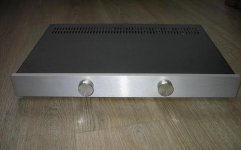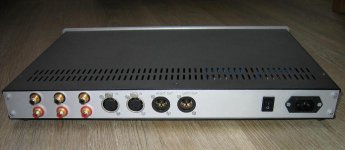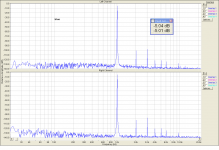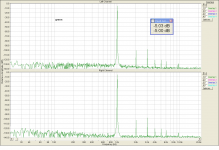Harder question (may have nothing to do with blind test) is: how critical is the “fatiguing” phenomenon? What will be the symptoms? Will and how this could possibly affect the deaf listeners? Can I make a circuit that is not fatiguing? Can this fatiguing aspect be quantified? What physical parameters are in effect?
I think one significant cause of fatigue is inaudible high frequency in the output from the speakers. If you have instability in the chain and get high frequency oscillation or high frequency noise then you will get fatigued.
I have had ground loops that have caused this problem in my amp.
I think this is the main problem with op amps: they have a lot of gain at HF. You have to have a very good implementation to keep the noise out and maintain stability.
It's easy to test. Just output some inaudible HF noise and wait for your ears to start bleeding and all the little hairs to fall out.
You'll then be able to do a follow up to see if the fatigue problem affects deaf people.
I probably sound really lazy but its hard to sort through all of the big words to find what I'm looking for.
And what difference did that produce in the sound?
I remember in the PM I said I first had a hunch the bass was slightly different but then later concluded that I couldn't tell the difference. I was listening with some average consumer grade sony headphones.
😕
I am not a scientist but an engineer & designer. I regard a Blind Listening Test as a measurement.Take simple example, if it is the green preamp that I want to produce, is it good enough to ensure BEP or success in the market from sound quality perspective? How can I answer that through a blind test? Who should be the listeners, and how to determine it? This is still simple, and you know it.
I may be wrong but I believe that making a product sound better actually helps it sell .. in spite of the huge amount of deaf Goldein Pinnae sh*t flying around.
Some interesting results from nearly 2 decades of tests :
Audio reviewers do significantly worse than the man-in-the-street. In fact apart from a VERY few exceptions, you are justified in assuming all reviewers are deaf.
I was pleased to find this Millenium that another group that has DBLT data on famous reviewers found the same thing .. except they can't publish the results cos they are still in the industry. I could but some of these reviewers are also my personal friends.
The woman-in-the-street is usually significantly more perceptive than the man .. even if they profess no interest in our toys. So if your girlfriend, wife or mother walks in and says, "I like your old one better", you'd better listen 😱
There was a period when anyone who visited our factory for any reason would be roped in to take part in whatever DBLT that was happening.
So I design stuff which the true golden pinnae and the man/woman-in-the-street will prefer.
For the deaf ones including most reviewers, I polish my "Hand carved by Virgins from Solid Unobtainium" story. 🙂
This is an important point which I address in my tests but not sure how we can do this for an internet test.Harder question (may have nothing to do with blind test) is: how critical is the “fatiguing” phenomenon? What will be the symptoms? Will and how this could possibly affect the deaf listeners? Can I make a circuit that is not fatiguing? Can this fatiguing aspect be quantified? What physical parameters are in effect?
The most useful 'cure' is to let the listener choose his own music and levels (though matching levels for the different 'presentations' is separate).
I personally don't regard a test as valid unless the listener 'likes' at least one of the 'presentations'. If he thinks some of the other 'presentations' are fatiguing, this is a valid result and some of my true golden pinnae have expressed this with great reliability even when they can't articulate exactly what is wrong.
In at least one case, this led to important new considerations for the design of good Digital Filters.
Last edited:
I would like to thank everyone who have participated in the poll, everyone posting their comments and I would especially like to thank Mooly for his tremendous help and enthusiasm.
Here is the blue and green DUT.
What coupling do D/A and A/D stages use?
Are clocks slaved?
What is IR for 'blue' path using MLS? (Or swept setup that captures DC)
IMD testing with RightMark doesn't produce super low frequency difference components associated with broadband stimulus; once again, analyzer is not setup to resolve frequencies below 20Hz.
Indeed, 'green' circuit may effectively only be adding 1u decoupling capacitor.
kgrlee: Cool Edit Pro was used for SRC.
I agree that each listener should have a choice of his own music, that's what I always do with my visitors. Unfortunately, I am not able to upload the complete preamplifier hardware on some file server in case of the web poll. Teleporting has not been successfully resolved yet 😉
And now color? If the color issue is still a big problem, the whole idea could be too big to solve.
I agree with you on this.
If the test method becomes the only imperative, it may easily happen that all the sound differences are erased. For the same reason. We concentrate on the method and not the music.
Thank you for the test....... I enjoy them!mohammed li said:***link now removed as poll and test is over***
I am owing you photos of the 'green' under test 😉
The AD797 is already replaced with OPA637.
Immaculately constructed as always 🙂 Very nice.
My attention focused on the PSU's. Two seemingly similar PCB's but very different parts such as the rectifiers. Big diode and little diode (is it D3 and D4 ?) in the left one, and different types of caps and even resistors.
A lot happened when I was away. 😀
The results are as expected now we know what the d.u.t. were.
Edit: There is no statistically significant preference.
Please more tests like this, but now with ABX results posted.
The results are as expected now we know what the d.u.t. were.
Edit: There is no statistically significant preference.
Please more tests like this, but now with ABX results posted.
Last edited:
Oh, just what I had at the moment 🙂. The supply with lower voltage is for relays only.
Last edited:
Just for fun, FFT 1kHz of blue and green separately and the put into one image. The same "difference" is for 100Hz or 10kHz.
('Blue' is the D/A-A/D direct (wire) and 'green' is D/A-preamp-A/D).
('Blue' is the D/A-A/D direct (wire) and 'green' is D/A-preamp-A/D).
Attachments
Last edited:
Oh, just what I had at the moment 🙂. The supply with lower voltage is for relays only.
I wondered 😀
Thanks.
I guess that before to delve inside the "fatiguing phenomenom" implicancies, it will be more useful to answer your a-bit-extended last question:Harder question (may have nothing to do with blind test) is: how critical is the “fatiguing” phenomenon? What will be the symptoms? Will and how this could possibly affect the deaf listeners? Can I make a circuit that is not fatiguing? Can this fatiguing aspect be quantified? What physical parameters are in effect?
What physical and psychological parameters are in effect?
and perhaps better yet:
What is the relationship between "fatiguing phenomenom" and audio electronics?... assuming it is real, of course.
Thanks Pavel for the FFT plots. I just don't see enough difference there to account for the tiny, but real, difference in sound. Wonder what it is?
Pano, I do not know. I have been encountering similar situations many times in last 10 years, when I am active in audio again, as a serious hobby at least. Maybe now some will have more understanding for what is often written in BT JC thread. Above certain level (power supplies, parts selection, RFI killing etc.), similar situations are very usual.
Root causes are at root of spectrum.
Demonstration with sample rate conversion from 48kHz to 375 is like using FFT of 2^16 v 2^22.
Results comparing 1kHz v sum of 1kHz with 1005Hz will likely look different <20Hz.
Demonstration with sample rate conversion from 48kHz to 375 is like using FFT of 2^16 v 2^22.
Results comparing 1kHz v sum of 1kHz with 1005Hz will likely look different <20Hz.
So does that mean that standard/typical FFT resolutions are not good enough.Thanks Pavel for the FFT plots. I just don't see enough difference there to account for the tiny, but real, difference in sound. Wonder what it is?
Dan.
To me, it has been a fact for more than 10 years. Above certain quality level, FFT says nothing. It only reveals huge faults.
So does that mean that standard/typical FFT resolutions are not good enough.
Dan.
No, it just mean conclusions unsupported by evidence are being made and accepted as fact. That's the problem with acting scientific but not being scientific.
BTW, the idea that a frequency response plot or a spectrum is sufficient is incorrect. They're necessary, though. I'd have no problem putting together a pair of files from DUTs that show identical distortion, level, and frequency response, but are 100% audibly different.
- Status
- Not open for further replies.
- Home
- General Interest
- Everything Else
- Ultimate listening test ... test your ears and audio chain





